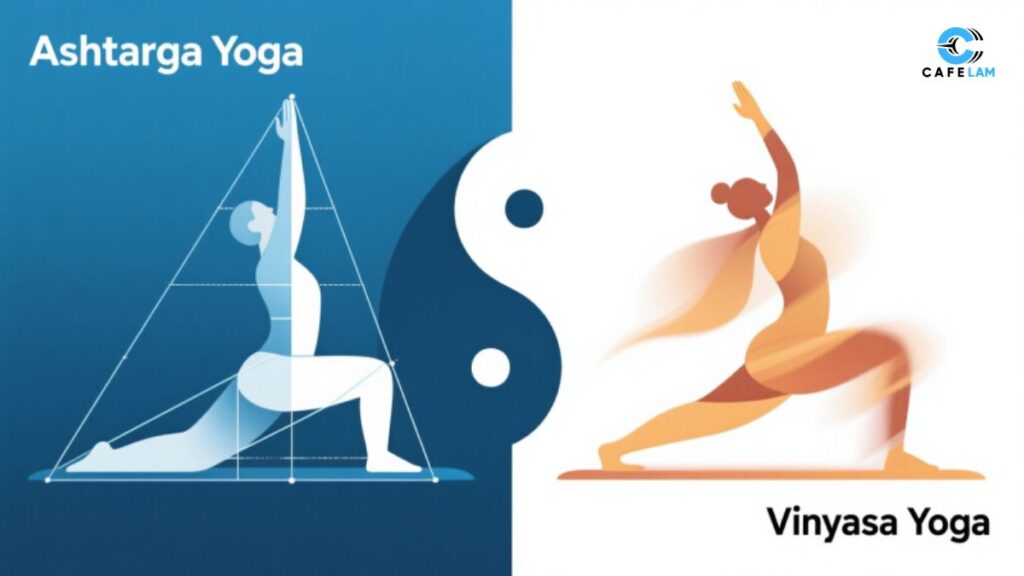Yoga, a centuries-old practice, offers a variety of styles that focus on different aspects of physical and mental well-being. Among the many forms of yoga, Ashtanga and Vinyasa are two of the most popular, often confused due to their similarities. However, they are distinct in several ways, each offering unique benefits for practitioners. In this article, we’ll explore Ashtanga vs Vinyasa Yoga, focusing on their differences, benefits, and which style might be best suited for you.
What is Ashtanga Yoga?
Ashtanga Yoga, founded by Sri K. Pattabhi Jois, is a traditional and rigorous style of yoga that follows a set sequence of postures. This style of yoga is known for its structured and disciplined approach. The word “Ashtanga” translates to “eight-limbed,” referring to the eight components of the practice outlined in the Yoga Sutras of Patanjali, which include ethical guidelines, meditation, and physical postures (asanas). The primary focus of Ashtanga yoga is the synchronization of breath with movement, also known as Ujjayi breath, which creates internal heat and detoxifies the body.
Ashtanga Yoga involves performing a specific series of poses in a particular order. These sequences are generally divided into six series: Primary, Intermediate, Advanced A, Advanced B, and variations within each. The first series, known as the Primary Series, is the most commonly practiced and includes fundamental poses meant to build strength and flexibility.
What is Vinyasa Yoga?
Vinyasa Yoga, often referred to as “flow yoga,” is a more fluid and dynamic form of yoga that emphasizes the connection between breath and movement. Unlike Ashtanga, which follows a set sequence, Vinyasa allows for greater creativity and variation in the postures, making it more adaptable to individual needs and preferences. The term “Vinyasa” refers to the arrangement of the poses and the seamless transition from one posture to the next, linking them with breath.
Vinyasa classes typically flow from one pose to another in a continuous sequence, creating a rhythm that is both calming and energizing. While some Vinyasa classes may follow a set sequence, such as Sun Salutations, there is often more flexibility and variation in how poses are combined and sequenced. This style is commonly practiced in more modern yoga settings and is popular for those seeking a balance between strength, flexibility, and relaxation.
Key Differences Between Ashtanga and Vinyasa Yoga
Although both Ashtanga and Vinyasa Yoga share similarities in their emphasis on breath and movement, there are several key differences that set them apart.
Structure and Sequence:
Ashtanga Yoga follows a rigid structure, with each class focusing on a specific sequence of postures that must be practiced in the same order. This repetition is designed to deepen practitioners’ understanding of their bodies and enhance their discipline over time. In contrast, Vinyasa Yoga is much more flexible. While some Vinyasa classes may follow a similar sequence, there is often room for creativity, and the poses can be modified to suit individual needs.
Pace and Intensity:
Ashtanga is generally faster-paced and more intense due to its fixed sequence of postures. This style of yoga is often more physically demanding, requiring practitioners to hold poses for longer periods and move quickly between transitions. Vinyasa Yoga, while also energetic, can be practiced at a slower pace, making it more accessible for beginners or those seeking a less intense workout.
Breathing Technique:
Both Ashtanga and Vinyasa emphasize the connection between breath and movement, but the way this is achieved differs. Ashtanga uses Ujjayi breath, a specific technique involving a slight constriction in the throat, creating an ocean-like sound. This breath is used throughout the practice to build heat and focus the mind. In Vinyasa Yoga, the breath is also important, but it may not always follow the same specific pattern as in Ashtanga. The focus is more on inhaling and exhaling in coordination with movement, allowing for greater freedom and flexibility in the practice.
Level of Rigidity:
Ashtanga Yoga is known for its strict adherence to tradition. The same poses are practiced in the same order every time, and there is less room for deviation from the sequence. Vinyasa Yoga, on the other hand, is more fluid and adaptable. The instructor may vary the sequence based on the class’s needs, and students are often encouraged to experiment with different variations of poses.
Class Experience:
The atmosphere in an Ashtanga class is typically more focused and disciplined. Ashtanga practitioners are often expected to practice regularly and progress through the different series, which can require years of dedication. Vinyasa classes, however, tend to have a more relaxed and creative atmosphere, with classes that can range from gentle flows to more advanced challenges. The emphasis in Vinyasa is on fluid movement and enjoyment, making it a great option for those who want a more enjoyable, less rigid practice.
Which Style Is Right for You?
Choosing between Ashtanga and Vinyasa Yoga depends on your personal fitness goals, experience level, and preferences. If you enjoy a structured, disciplined approach and are looking for a challenging, physically demanding workout, Ashtanga Yoga may be the right choice for you. Its set sequences and emphasis on building strength and flexibility can be perfect for those looking to make steady progress over time.
On the other hand, if you prefer a more flexible and dynamic practice that allows for creativity and variation, Vinyasa Yoga might be a better fit. The freedom to explore different poses and sequences makes Vinyasa an excellent option for beginners or anyone who enjoys a less rigid yoga experience.
Benefits of Ashtanga Yoga
-
Improved Flexibility and Strength: The continuous flow of postures and emphasis on breath allows for greater flexibility and strength, particularly in the core and legs.
-
Detoxification: The heat generated through Ujjayi breath helps to sweat out toxins and cleanse the body.
-
Mental Focus: The repetitive nature of the sequences helps to quiet the mind and increase concentration, providing mental clarity.
-
Discipline: Practicing the same series of poses each time creates a sense of discipline and consistency.
Benefits of Vinyasa Yoga
-
Variety and Creativity: The flexibility of Vinyasa classes allows practitioners to explore different sequences and poses, making it more engaging.
-
Cardiovascular Benefits: The fluid movements and transitions between poses offer a cardiovascular workout that can help improve overall heart health.
-
Stress Relief: The dynamic flow of Vinyasa Yoga can help release tension and reduce stress while promoting relaxation.
-
Accessibility: Vinyasa Yoga can be adapted to suit various skill levels, making it ideal for beginners and advanced practitioners alike.
Conclusion
Both Ashtanga vs Vinyasa Yoga offer unique benefits, with each style suited to different types of practitioners. Whether you prefer the structure and discipline of Ashtanga or the fluid, creative flow of Vinyasa, both styles provide a powerful way to enhance your physical fitness, mental clarity, and overall well-being. By understanding the key differences, you can make an informed decision about which style of yoga best aligns with your goals and lifestyle.
Curious to learn more? Dive into the rest of our blog for helpful tips and insights!
Frequently Asked Questions (FAQs)
1. Can beginners practice Ashtanga Yoga?
Ashtanga Yoga is a physically demanding practice, and beginners may find it challenging at first. However, it can be adapted to suit beginner-level practitioners by modifying certain poses and starting with the Primary Series.
2. How does Vinyasa Yoga compare to other forms of yoga?
Vinyasa Yoga is unique in its fluidity and flexibility. Unlike other styles like Hatha or Iyengar, which emphasize alignment and static poses, Vinyasa is dynamic and focuses on the connection between breath and movement.
3. Can I lose weight with Ashtanga or Vinyasa Yoga?
Both Ashtanga and Vinyasa Yoga offer a great cardiovascular workout that can help with weight loss. Ashtanga, in particular, with its fast-paced nature, can be highly effective for burning calories and toning muscles.
4. How often should I practice Ashtanga or Vinyasa Yoga?
For optimal benefits, it is recommended to practice yoga at least 3-4 times per week. Ashtanga practitioners often follow a daily routine, while Vinyasa practitioners may practice 2-3 times a week for variety.
5. Can Vinyasa Yoga help with stress and anxiety?
Yes, Vinyasa Yoga can be incredibly beneficial for stress relief. The focus on breath and flow helps to activate the parasympathetic nervous system, promoting relaxation and reducing anxiety.







